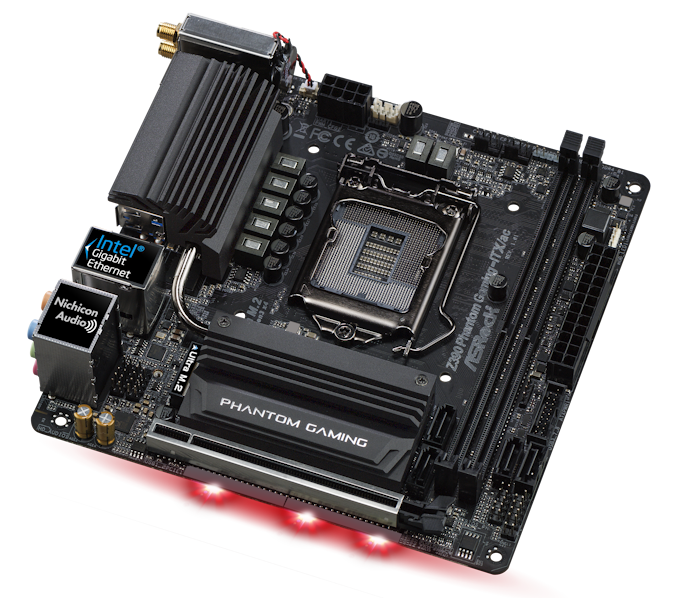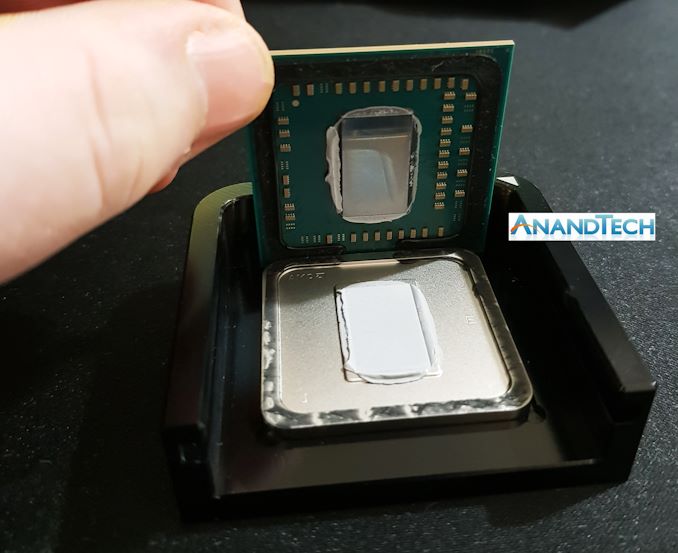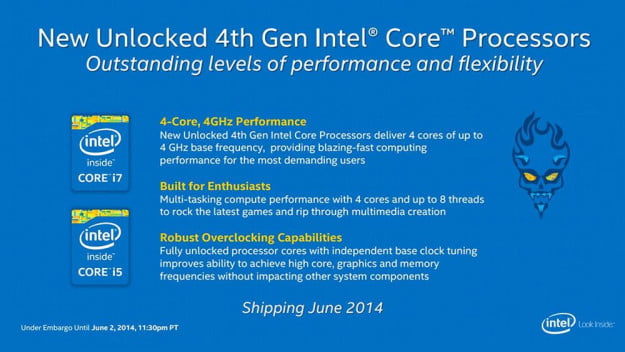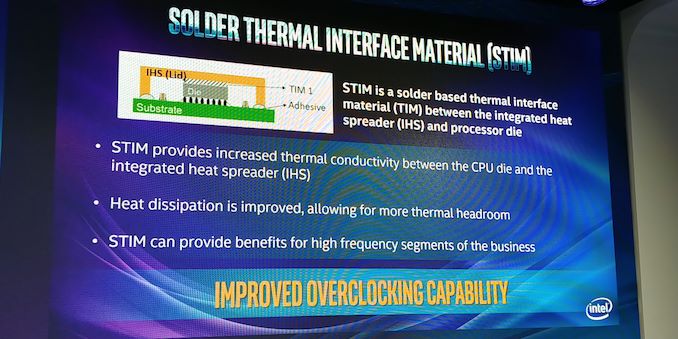The Intel 9th Gen Review: Core i9-9900K, Core i7-9700K and Core i5-9600K Tested
by Ian Cutress on October 19, 2018 9:00 AM EST- Posted in
- CPUs
- Intel
- Coffee Lake
- 14++
- Core 9th Gen
- Core-S
- i9-9900K
- i7-9700K
- i5-9600K
Hardware and Software Security Fixes
The Spectre and Meltdown vulnerabilities made quite a splash earlier this year, forcing makers of hardware and software to release updates in order to tackle them. There are several ways to fix the issues, including software, firmware, and hardware updates. Each generation of product is slowly implementing fixes, including some of the new 9th Generation processors.
At this point Intel has split the list down into 5/6 wide variants of different types of vulnerabilities. For all processors beyond mid-2018, here is what the fix table looks like:
| Spectre and Meltdown on Intel | |||||||
| AnandTech | SKX-R 3175X |
CFL-R | Cascade Lake | Whiskey Lake |
Amber Lake |
||
| Spectre | Variant 1 | Bounds Check Bypass | OS/VMM | OS/VMM | OS/VMM | OS/VMM | OS/VMM |
| Spectre | Variant 2 | Branch Target Injection | Firmware + OS | Firmware + OS | Hardware + OS | Firmware + OS | Firmware + OS |
| Meltdown | Variant 3 | Rogue Data Cache Load | Firmware | Hardware | Hardware | Hardware | Firmware |
| Meltdown | Variant 3a | Rogue System Register Read | Firmware | Firmware | Firmware | Firmware | Firmware |
| Variant 4 | Speculative Store Bypass | Firmware + OS | Firmware + OS | Firmware + OS | Firmware + OS | Firmware + OS | |
| Variant 5 | L1 Terminal Fault | Firmware | Hardware | Hardware | Hardware | Firmware | |
The new 9th Generation processors, listed as CFL-R (Coffee Lake Refresh), has implemented hardware fixes for variant 3, Rogue Data Cache Load, and variant 5, L1 Terminal Fault.
Because the new chips have required new masks for manufacturing, Intel has been able to make these changes. The goal of moving the changes into hardware means that the hardware is always protected, regardless of OS or environment, and with the hope that any additional overhead created by a software fix can be lessened if done in hardware.
(S)TIM: Soldered Down Processors
With the desktop processors we use today, they are built from a silicon die (the smart bit), a package substrate (the green bit), a heatspreader (the silver bit), and a material that helps transfer heat from the silicon die to the heatspreader. The quality of the binding between the silicon die and the heatspreader using this thermal interface material is a key component in the processors ability to remove the heat generated from using it.
Traditionally there are two different types of thermal material: a heat conductive paste, or a bonded metal. Both have positives and negatives.
The heat conductive paste is a universal tool – it can be applied to practically any manufactured processor, and is able to deal with a wide range of changing conditions. Because metals expand under temperature, when a processor is used and gets hot, it expands – so does the heatspreader. The paste can easily deal with this. This allows paste-based processors to live longer and in more environments. Using a bonded metal typically reduces the level of thermal cycling possible, as the metal also expands and contracts in a non-fluid way. This might mean the processors has a rated lifespan of several years, rather than a dozen years. However, the bonded metal solution performs a lot, lot better – metal conducts heat better than the silicon-based pastes – but it is slightly more expensive (a dollar or two per unit, at most, when the materials and manufacturing are taken into account).
| Thermal Interface | |||||||
| Intel | Celeron | Pentium | Core i3 | Core i5 | Core i7 Core i9 |
HEDT | |
| Sandy Bridge | LGA1155 | Paste | Paste | Paste | Bonded | Bonded | Bonded |
| Ivy Bridge | LGA1155 | Paste | Paste | Paste | Paste | Paste | Bonded |
| Haswell / DK | LGA1150 | Paste | Paste | Paste | Paste | Paste | Bonded |
| Broadwell | LGA1150 | Paste | Paste | Paste | Paste | Paste | Bonded |
| Skylake | LGA1151 | Paste | Paste | Paste | Paste | Paste | Paste |
| Kaby Lake | LGA1151 | Paste | Paste | Paste | Paste | Paste | - |
| Coffee Lake | 1151 v2 | Paste | Paste | Paste | Paste | Paste | - |
| CFL-R | 1151 v2 | ? | ? | ? | K = Bonded | - | |
| AMD | |||||||
| Zambezi | AM3+ | Bonded | Carrizo | AM4 | Bonded | ||
| Vishera | AM3+ | Bonded | Bristol R | AM4 | Bonded | ||
| Llano | FM1 | Paste | Summit R | AM4 | Bonded | ||
| Trinity | FM2 | Paste | Raven R | AM4 | Paste | ||
| Richland | FM2 | Paste | Pinnacle | AM4 | Bonded | ||
| Kaveri | FM2+ | Paste / Bonded* | TR | TR4 | Bonded | ||
| Carrizo | FM2+ | Paste | TR2 | TR4 | Bonded | ||
| Kabini | AM1 | Paste | |||||
| *Some Kaveri Refresh were bonded | |||||||
In our Ryzen APU delidding article, we went through the process of removing the heatspreader and conductive paste from a popular low cost product, and we showed that replacing that paste with a bonded liquid metal improved temperatures, overclocking, and performance in mid-range overclocks. If any company wants to make enthusiasts happy, using a bonded metal is the way to go.
For several years, Intel has always stated that they are there for enthusiasts. In the distant past, as the table above shows, Intel provided processors with a soldered bonded metal interface and was happy to do so. In recent times however, the whole product line was pushed into the heat conductive paste for a number of reasons.
As Intel was continually saying that they still cared about enthusiasts, a number of users were concerned that Intel was getting itself confused. Some believed that Intel had ‘enthusiasts’ and ‘overclockers’ in two distinct non-overlapping categories. It is what it is, but now Intel has returned to using applying STIM and wants to court overclockers again.
Intel has officially confirmed that new 9th generation processors will feature a layer of solder making up the TIM between the die and the IHS. The new processors with solder include the Core i9-9900K, the Core i7-9700K and Core i5-9600K.
As we’ll show in this review, the combination of STIM plus other features are of great assistance when pushing the new processors to the overclocking limits. Intel’s own overclocking team at the launch event hit 6.9 GHz temporarily using exotic sub-zero coolants such as liquid nitrogen.
Motherboards and the Z390 Chipset
One of the worst kept secrets this year has been Intel’s Z390 chipset. If you believe everything the motherboard manufacturers have told me, most of them had been ready for this release for several months, hence why seeing around 55 new motherboards hit the market this month and into next.
The Z390 chipset is an update to Z370, and both types of motherboards will support 8000-series and 9000-series processors (Z370 will need a BIOS update). The updates are similar to the updates seen with B360: native USB 3.1 10 Gbps ports, and integrated Wi-Fi on the chipset.
| Intel Z390, Z370 and Z270 Chipset Comparison | |||
| Feature | Z390 | Z370 | Z270 |
| Max PCH PCIe 3.0 Lanes | 24 | 24 | 24 |
| Max USB 3.1 (Gen2/Gen1) | 6/10 | 0/10 | 0/10 |
| Total USB | 14 | 14 | 14 |
| Max SATA Ports | 6 | 6 | 6 |
| PCIe Config | x16 x8/x8 x8/x4/x4 |
x16 x8/x8 x8/x4/x4 |
x16 x8/x8 x8/x4/x4 |
| Memory Channels | 2 | 2 | 2 |
| Intel Optane Memory Support | Y | Y | Y |
| Intel Rapid Storage Technology (RST) | Y | Y | Y |
| Max Rapid Storage Technology Ports | 3 | 3 | 3 |
| Integrated 802.11ac WiFi MAC | Y | N | N |
| Intel Smart Sound | Y | Y | Y |
| Integrated SDXC (SDA 3.0) Support | Y | N | N |
| DMI | 3.0 | 3.0 | 3.0 |
| Overclocking Support | Y | Y | Y |
| Intel vPro | N | N | N |
| Max HSIO Lanes | 30 | 30 | 30 |
| Intel Smart Sound | Y | Y | Y |
| ME Firmware | 12 | 11 | 11 |
The integrated Wi-Fi uses CNVi, which allows the motherboard manufacturer to use one of Intel’s three companion RF modules as a PHY, rather than using a potentially more expensive MAC+PHY combo from a different vendor (such as Broadcom). I have been told that the cost of implementing a CRF adds about $15 to the retail price of the board, so we are likely to see some vendors experiment with mid-price models with-and-without Wi-Fi using this method.

ASRock Z390 Phantom Gaming-ITX/ac
For the USB 3.1 Gen 2 ports, Type-A ports are supported natively and motherboard manufacturers will have to use re-driver chips to support Type-C reversibility. These come at extra cost, as one might expect. It will be interesting to see how manufacturers mix and match the Gen 2, Gen 1, and USB 2.0 ports on the rear panels, now they have a choice. I suspect it will come down to signal integrity on the traces on the motherboard.
For the Z390 chipset and motherboards, we have our usual every-board-overview post, covering every model the manufacturers would tell us about. Interestingly there is going to be a mini-ITX with Thunderbolt 3, and one board with a PLX chip! There are also some motherboards with Realtek’s 2.5G Ethernet controller – now if only we also had consumer grade switches.















274 Comments
View All Comments
ChefJoe - Friday, October 19, 2018 - link
I have two wants.1 - I really want to see the overclocked 9600k vs overclocked 8600k, as the chart differences of it in this early draft of your 9900k-focused review are likely the wildly different clock speeds of the 86 and 96 parts.
2 - I still want to hear what happens when you drop one of these refresh parts in an older z370 board with an older bios. Do boards that were ok with 8600k refuse to boot a 9600k?
ChefJoe - Friday, October 19, 2018 - link
ack, 9700k-focused at this point. The 9900k overclock part of the review (and presumably 9600k eventually) is still pending.Ghan - Friday, October 19, 2018 - link
My plan was to upgrade from my current i7 6700k to the i7 9700k, and this article seems to confirm that my plan is a decent one. Doubling the core count from 4 to 8 is a decent value. I don't really see the point in paying an extra $100+ just for HT and slightly more cache.This release seems a bit tarnished by the fact that it is still the same process node we've had for years now. Addition of cores is great, but it's not without some cost. Still, perhaps we wouldn't even have this improvement if it weren't for AMD's strong return to the enthusiast CPU market. Hopefully the next year will be even more interesting.
Arbie - Friday, October 19, 2018 - link
"Addition of cores is great, but it's not without some cost. Still, perhaps we wouldn't even have this improvement if it weren't for AMD's strong return to the enthusiast CPU market."It's actually with a LOT of cost. And you should consider whom you're going to reward with your business: the big fat company that milked us for ten years and did everything legal and illegal to crush their competition, or the struggling firm that miraculously came from behind and reignited the market. Make your own choice, but if you buy Intel merely to have the fastest today, you're voting for sad tomorrows.
Lazlo Panaflex - Friday, October 19, 2018 - link
Well said, Arbie. Ryzen 2600 (non X) with decent stock cooler for $160 at Newegg = epic win.mapesdhs - Sunday, October 21, 2018 - link
My next new build will definitely be AMD. Looking forward to it.billin30 - Friday, October 19, 2018 - link
Maybe I am just slow in my upgrading, but my 4770k is still going strong. I am in the market for an upgrade, but I would like to see what sort of difference in performance I can expect. Its nice to see all the latest CPU's on this list, but you don't get a ton of deviation when you have CPU's that are so close in performance. It would interesting to see some benchmarks based on the previous generations top performing CPU's so we can see what sort of performance improvements we would get when moving up from past generations. I feel like a lot of people hang onto their core system components for many generations and it would be beneficial for those people to see these numbers.DanNeely - Friday, October 19, 2018 - link
This is a new set of CPU benchmarks and Ian hasn't had time to retest his other 50+ CPUs yet. From prior history that should happen as he has time and will show up as additional data points in bench.I don't think you're particularly slow about upgrading. For gaming purposes a high end CPU is reasonable to keep for 6-10 years now; possibly even a bit longer if you're only using a midrange GPU and are willing to accept the higher risk of having to build a new system with zero notice because something dies unexpectedly. I'm in a similar spot with my 4790k; and unless games needing more than 4/8 cores start becoming common am planning to keep it for at least 2 or 3 more years.
That should hopefully be long enough that Spectre stops generating frequent new exploits and mitigation is fully in hardware, that PCIe4 (or 5), DDR5, and significant numbers of USB-C ports are available. Also possibly out by then, widespread TB3, or DMI being less of a potential bottleneck on intel CPUs (either a major speedup or additional PCIe for SSDs on the CPU). Also by then either Intel should finally have it's manufacturing unfubarred or if not, AMD will likely have captured the single threaded performance crown while holding onto the multi-threaded one meaning I can have both the ST perf that many games still benefit from and the MT perf for my non-gaming uses that can go really wide.
wintermute000 - Saturday, October 20, 2018 - link
I'm haswell at 1440p too and the charts have confirmed that I'm holding on for another generation. No sense paying 1500 (32gb RAM) for a platform upgrade to get a few % more frames (and it's fine for my productivity tasks, still faster than new laptops lol)Icehawk - Saturday, October 20, 2018 - link
I only upgraded from my 4770 to an 8700 because my wife’s i5 4xxx rig died and it gave me an excuse to upgrade my encoding power. I see no difference gaming with a 970. Also I don’t notice increased performance really anywhere except encoding and decompressing during my daily use.